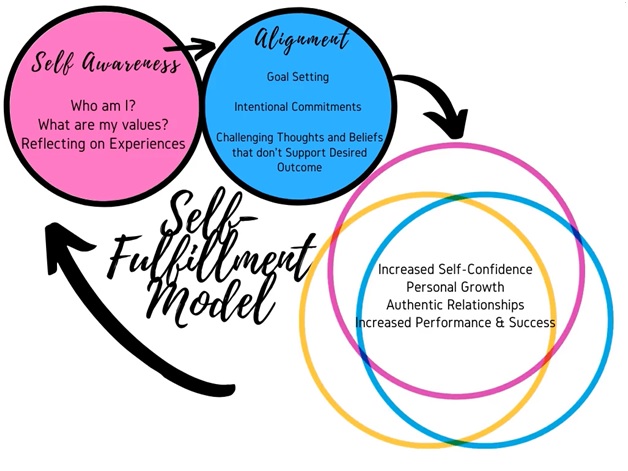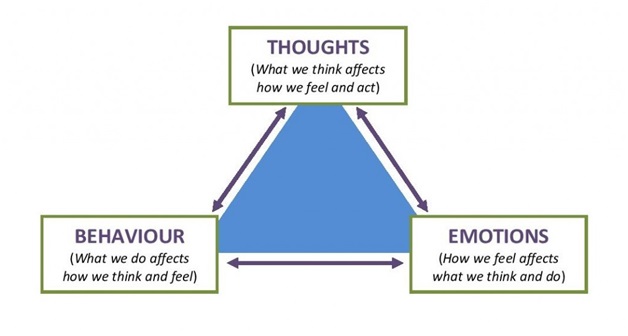A Coaching Model Created by Nicole Kett
(Transformational Coach, UNITED STATES)

Like a flower, humans go through life cycles. We are constantly growing and redefining who we are based on our experiences and challenges. As we grow to a peak of beauty and mastery; we have to understand that this is both the end of one cycle and the beginning of another. To believe that we have ever fully arrived at a final destination is to strip our lives of fulfillment. The above model explains the process we go through as we understand who we are, set and reach new goals, and gain more trust in ourselves. This is the process of finding self-fulfillment.
Step 1: Self-Awareness
The first step in the process is to create awareness of who we are at this very moment. Humans are complex beings and can behave in similar manners across environments, but they can also bring out behaviors that are not true to their authentic selves in response to the environment they are in. Gaining an understanding of ourselves makes it more likely that we will be empowered to act in the alignment of who we are when we are faced with challenges (Sully, 1997). We also gain a better understanding of our strengths in situations and risks we may face. Greater self-awareness allows us to create a life that aligns with our motivations and is an important step before exploring a client’s goals. The first step is to work with the coach who will use tools and questions to help the client gain new perspectives and insight into who they are and how they interact with their environment.
In this step, tools discussed in my research around building self-awareness will be used. Self-awareness is a great foundation for change that can be used to help the client uncover parts of themselves and understand where they are. These tools include:
- Assessment Tools
- Values
- Wheel of Life
- Journaling
- Mindfulness
Step 2: Alignment
With a deeper understanding of who we are, it sets the foundation for the alignment phase. After the foundational self-awareness, it is time to dive deeper. When we begin to understand ourselves, our values, and our purpose, it gives us the unique ability to make adjustments where we are not living in authenticity. With this understanding, the client can commit to goals that begin to align their life. With the coach, the client will work to make intentional commitments —saying yes to the things that create alignment and clearing the things that pull them out. Working with the coach to uncover underlying (conscious or unconscious) beliefs and thoughts that hold the client’s backs begins to clear the path towards reaching goals. As the client becomes more aware of their thoughts, beliefs, and thoughts, they can be intentional around their own choices instead of reactionary.
In this phase of the model, the coach supports the client in setting structure and action around the goals that were set in Step 1.
The cognitive triangle can also be explored to begin to manage thoughts, feelings, and behaviors that result. What we think affects how we feel and act. This helps the client gain back the control to decide how they will respond and behave.

Specific tools that can be used in this phase include the use of Byron Katie’s process of self-inquiry for thoughts. This involves asking four simple questions about each thought or belief that causes us pain:
- Is it True?
- Can you know that it is true?
- How do you react when you believe that thought?
- Who would you be without the thought?
Another important part of this step is connecting to the emotions that come up and what the client is feeling in their body. For example—how can they recognize fear in their body? What does it feel like? Helping the client to understand the sensations they are feeling as they scan their body is an important connection to make. When pain is expressed but is supported and acknowledged it helps the client deal with emotions that are deeply rooted in thoughts (Leven, 2013). Clients who are given the ability to connect with and heal their emotional pain allow for healthy that leads to vitality and new energy.
Step 3: Flourishing
Flourishing (adj.) – marked by vigorous and healthy growth
Flourishing is the product of the pursuit and engagement of an authentic life that brings inner joy and happiness through meeting goals, being connected with life passions, and relishing in accomplishments through the peaks and valleys of life. –Lynn Soots
The combination of awareness of who we are and consciously choosing to align our lives with that truth leads to a lot of growth. The client begins to trust themselves. They gain self-confidence and begin to feel a sense of personal growth. This helps them continue to improve their success in all areas of their lives and allows them to build more authentic relationships with themselves and others. The client gains self-fulfillment from this process—and realizes that they must continue through this cycle to find continued self-fulfillment—yet each time they can achieve even greater things. According to the doctor of positive psychology, Martin Seligman, flourishing is the state we create when we increase our positive emotions, engage with the world and work, develop meaningful relationships, and find deep fulfillment. As Seligman suggests, this is what it means to live a good life. Flourishing is not a state or characteristic. Flourishing is not a static part of who you are—it requires consistent effort and engagement in the model above. The more space we create to uncover who we are and align our lives to what we desire, the more likely we are to spend time in this state.
References
“Flourishing in Positive Psychology: Definition + 8 Practical Tips (PDF).” PositivePsychology.com, 27 June 2019, positivepsychology.com/flourishing/.
Katie, Byron, and Stephen Mitchell. Loving What Is: Four Questions That Can Change Your Life. Harmony Books, 2002.
Leven, Daniel. “Using the Body to Help Clients Break Old Habits and Stuck Patterns.” Psychotherapy Networker, 2013, www.psychotherapynetworker.org/blog/details/931/connecting-emotions-to-a-felt-body-sense.
Patanella, Michael. “The Cognitive Triangle.” Medium, Real Life Resilience, 27 Sept. 2018, medium.com/real-life-resilience/the-cognitive-triangle-bdc4eb08a4f5.
Sully, Sarah E. “Jstor.” D-Lib Magazine, vol. 3, no. 1, 1997, DOI:10.1045/january97-sully.